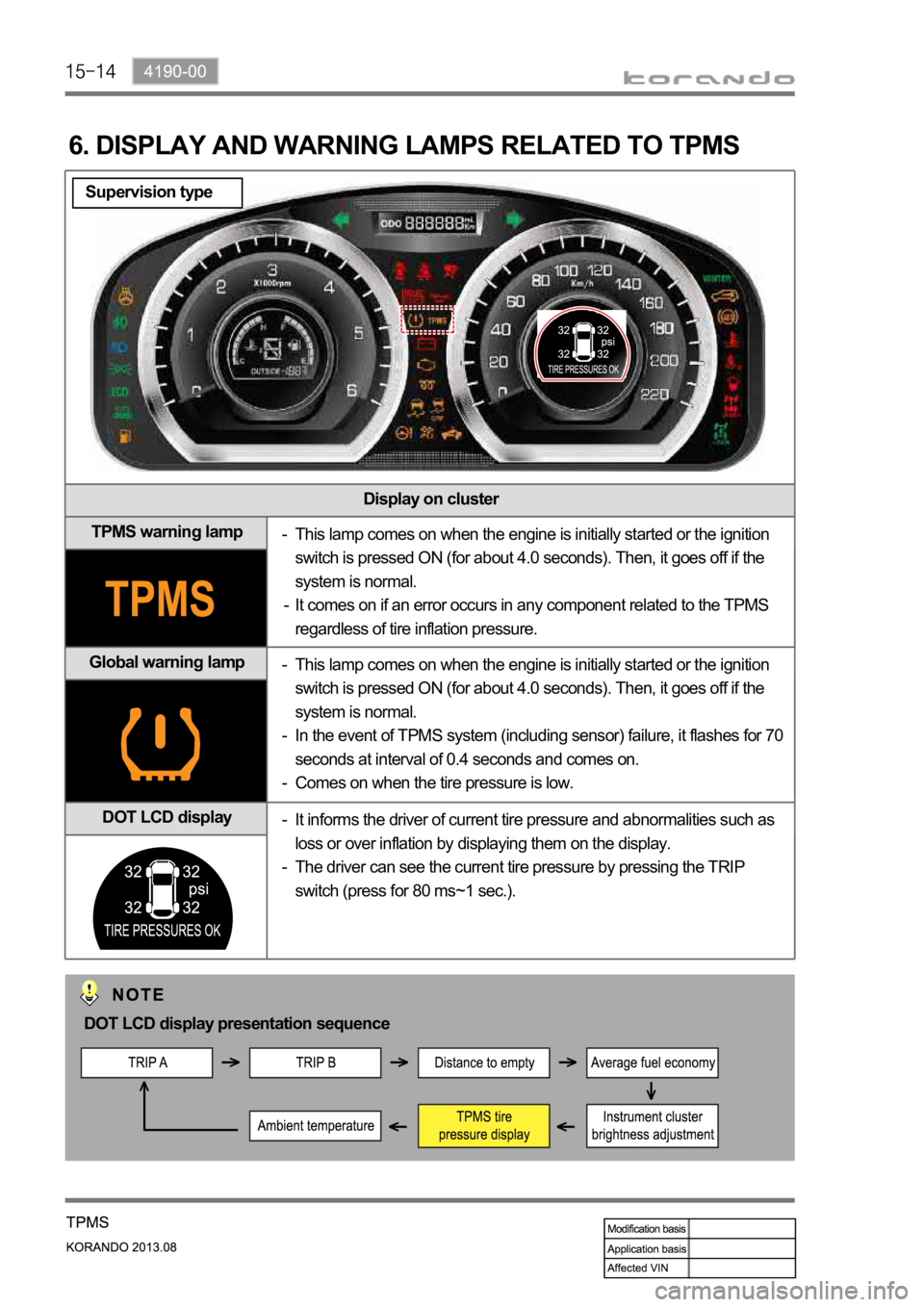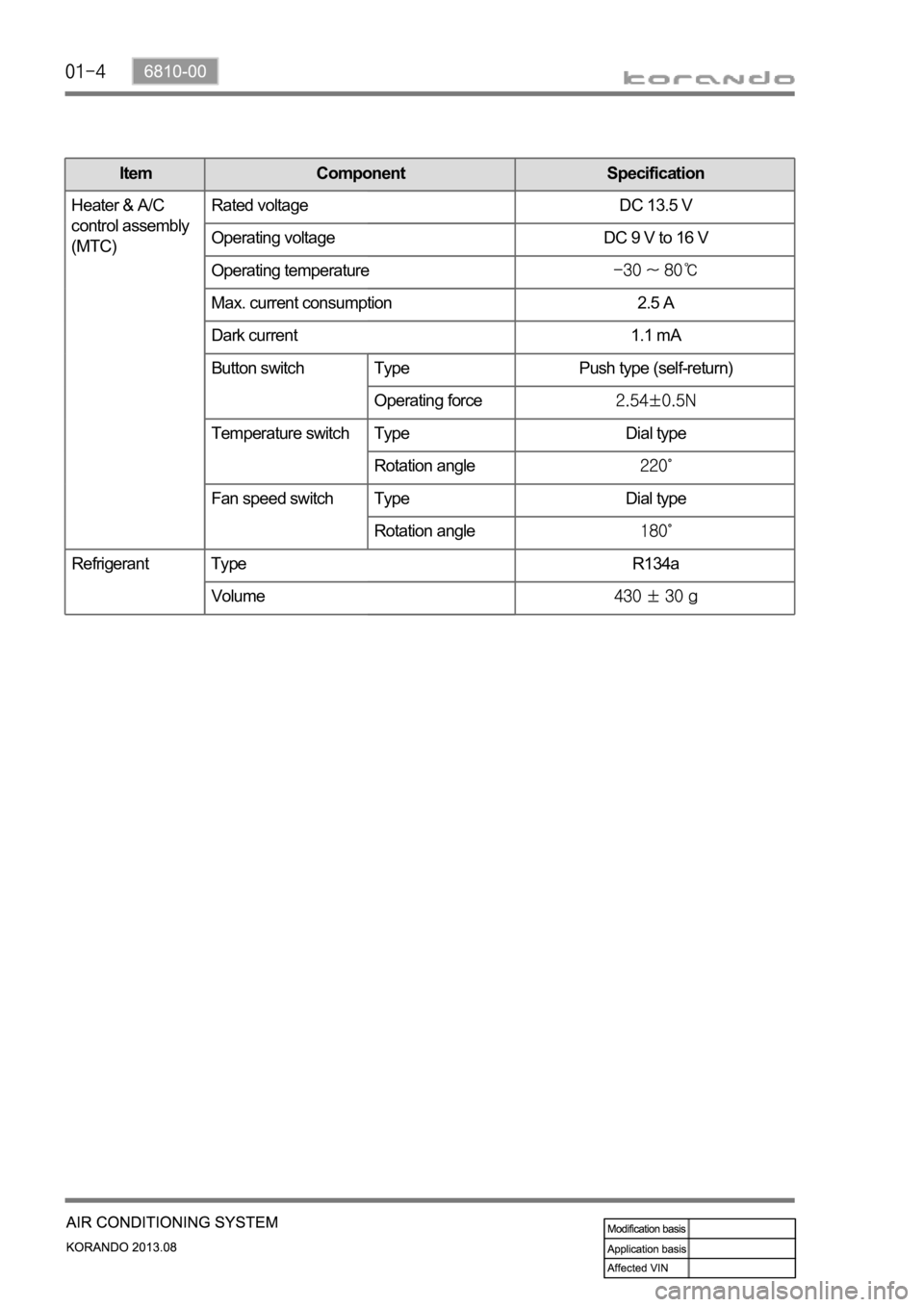SSANGYONG KORANDO 2013 Service Manual
Manufacturer: SSANGYONG, Model Year: 2013, Model line: KORANDO, Model: SSANGYONG KORANDO 2013Pages: 1336, PDF Size: 92.18 MB
Page 1181 of 1336

Display on cluster
TPMS warning lamp
Global warning lamp
DOT LCD display
6. DISPLAY AND WARNING LAMPS RELATED TO TPMS
This lamp comes on when the engine is initially started or the ignition
switch is pressed ON (for about 4.0 seconds). Then, it goes off if the
system is normal.
It comes on if an error occurs in any component related to the TPMS
regardless of tire inflation pressure. -
-
This lamp comes on when the engine is initially started or the ignition
switch is pressed ON (for about 4.0 seconds). Then, it goes off if the
system is normal.
In the event of TPMS system (including sensor) failure, it flashes for 70
seconds at interval of 0.4 seconds and comes on.
Comes on when the tire pressure is low. -
-
-
It informs the driver of current tire pressure and abnormalities such as
loss or over inflation by displaying them on the display.
The driver can see the current tire pressure by pressing the TRIP
switch (press for 80 ms~1 sec.). -
-
DOT LCD display presentation sequence
Supervision type
Page 1182 of 1336

4190-00
Display on cluster
TPMS warning lamp
Global warning lamp
DOT display
This lamp comes on when the engine is initially started or the ignition
switch is pressed ON (for about 4.0 seconds). Then, it goes off if the
system is normal.
It comes on if an error occurs in any component related to the TPMS
regardless of tire inflation pressure. -
-
This lamp comes on when the engine is initially started or the ignition
switch is pressed ON (for about 4.0 seconds). Then, it goes off if the
system is normal.
In the event of TPMS system (including sensor) failure, it flashes for 70
seconds at interval of 0.4 seconds and comes on.
Comes on when the tire pressure is low. -
-
-
The tire pressure for front wheels is displayed on the LCD display. The
tire pressure for rear wheels is displayed when pressing the Trip switch. -
Standard type
DOT display presentation sequence
Page 1183 of 1336

1) DOT LCD Display Related to TPMS
Status DOT LCD display Condition & illumination method
Correct tire pressureThe specified tire pressure is based on a
cold tire with the vehicle unloaded (no
Excessive tire pressureCorresponding status lamp blinks with
reverse shading at interval of 0.4 seconds if
tire pressure is 50 psi or higher
Low tire pressureWhen tire pressure is less than 13~20% of
specified value for a period of time,
corresponding status lamp blinks with
reverse shading for 70 seconds at interval o
f
0.4 seconds
Lower than minimum tire
pressureCorresponding status lamp comes on if tire
pressure is 24 psi or less
Sudden tire pressure lossCorresponding status lamp blinks with
shading reverse at interval of 0.4 seconds if
tire pressure changes more than 3 psi per 1
minute at speed of 0 km/h or above.
Imbalance between left and
right tire pressureCorresponding status lamps blink
alternately at interval of 1.0 second if tire
pressure differs by more than 4 psi in the left
and right tires while driving for more than 10
minutes
Impossible to determine tire
pressurePressure of the tire displayed as "--" when
not possible to determine tire pressure
correctly
* At initial start, the tire pressure can be
displayed after 10 minutes of driving at
speed of 20 km/h or higher
Supervision type
Page 1184 of 1336

4190-00
Standard type
Status Operating conditions Display
Tire pressure
displayAt initial start (more than 20 minutes have
elapsed after ignition off), the tire pressure is
not determined. It can be displayed after 10
minutes of driving at speed of 20 km/h or
higher.
FR - display
RR - displayIf the tire pressure is abnormal when it is not
The standard type instrument cluster shows
Low tire pressure warning
If the tire pressure is less than 13% of the proper value for more than 8 minutes, the 1st low tire
pressure warning is given. And, if the tire pressure is less than 20% for more than 4 minutes, the
2nd warning is given. The message "Check tire" is displayed on the instrument cluster DOT LCD
display.
(see "LOW TIRE PRESSURE WARNING in this section)
Priority of TPMS warnings
The situation can occur in which two warning messages are displayed depending on the vehicle
condition. If this happen, the warning messages are displayed according to the priority below.
Page 1185 of 1336

7. TIRE INFLATION PROCEDURE FOR VEHICLE WITH TPMS
1) Overview
For the vehicle with TPMS, the tire should be inflated in a method different from the conventional method
since the tire pressure values displayed on the tire pressure gauge and instrument cluster are different
after inflation.
The tire pressure displayed on the instrument cluster should be checked after a certain time delay
(wireless transmission time for wheel module).
The displayed value can be changed after driving even if it was set to the specified value.
2) Tire Inflation Procedure
Park the vehicle on a flat ground and let everyone get off the vehicle. A.
This symptom is occurred as the inflation pressure displayed on the instrument cluster becomes
different by tires as different load is applied to each tire due to driving condition, number of
occupants, irregular temperature change in tire and load condition.
If there is another vehicle equipped with the TPMS, keep the distance from this vehicle for at
least 5 mm to prevent interference of wheel module transmission.
Unload cargoes if they are usually not loaded during driving.
The instrument cluster does not display every pressure change while the air is injected or
discharged to/from the tire. This is because the wheel module sends the pressure value to the
TPMS ECU every minute.
In addition, if there are other vehicles with the TPMS nearby, it might take several minutes to
display the pressure values due to radio jamming and weather condition. -
-
-
Page 1186 of 1336

4190-00
Tire inflation procedure
Check tire pressure on instrument cluster
DOT LCD display
Normal tire pressure Improper tire pressure
Tire inflation & judgment B.
Fill the tire pressure (air) according to the tire inflation procedure. -
Fill specified tire pressure
(32 psi)
Drive vehicle at 20 km/h or higher
for less than 10 min.
If checking for the tire
shows it is normal, carry
out the work again
according to the tire
inflation procedure.
Finish
Not OK
OK
Supervision type
Standard type
Page 1187 of 1336

Cautions for TPMS tire inflation
If the tire pressure is 10 psi lower than
the specification (32 psi), replace the
valve insert on the wheel module valve
body with a new one and inject air into
the tire. -
Page 1188 of 1336

4190-00
8. CIRCUIT DIAGRAM
Page 1189 of 1336

6810-00
1. SPECIFICATIONS
Unit Item Specification
Heater
200 x 168.5 x 23.5
Capacity (kcal/h) 4,800
Evaporator
254.8 x 196.7 x 60
Capacity (kcal/h) 4,700
Blower motor Supply power (W) 240 + 10% Max (at 12 V)
Fan speed (rpm)
PTC Supply power 1 kW
Condenser
588 x 455 x 16 (2,625)
Capacity (kcal/h) 12,000
Capacity of receiver drier 250 cc
Compressor Volume 170 cc/rev
Diameter of pulley
Max. continuous speed 8,000 rpm
Voltage DC 12 V
Current consumption 2.2 A
Heater & A/C
control assembly
(FATC)Rated voltage DC 13.5 V
Operating voltage DC 9 V to 16 V
Operating temperature
Max. current consumption 2.5 A
Dark current 1.1 mA
Button switch Type Push type (self-return)
Operating force
Temperature & air
distribution switchType Dial type
Rotation angle
Page 1190 of 1336

Item Component Specification
Heater & A/C
control assembly
(MTC)Rated voltage DC 13.5 V
Operating voltage DC 9 V to 16 V
Operating temperature
Max. current consumption 2.5 A
Dark current 1.1 mA
Button switch Type Push type (self-return)
Operating force
Temperature switch Type Dial type
Rotation angle
Fan speed switch Type Dial type
Rotation angle
Refrigerant Type R134a
Volume